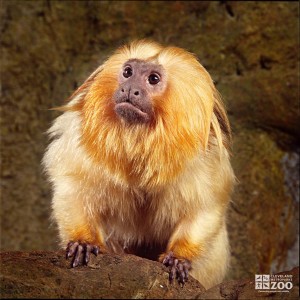Golden Lion Tamarin
[Leontopithecus rosalia]

The Golden Lion Tamarin is one of the most strikingly colored of all mammals and, unfortunately, one of the most highly endangered. This Tamarin has a magnificent pale to rich reddish-gold coat, and a long, back-swept mane that covers the ears and frames the dark, almost bare face. Adult body length is from 13 to 16 inches, the tail is from 10 to 15 inches long, and the weight from 22 to 25 ounces.
Golden Lion Tamarins live in family groups, and are dependent for shelter upon the hollows that are found in the trunks of old trees. The young are born fully furred and with their eyes open, and weigh an average of 2 ounces. Within a few days after birth the father begins to carry the infant at times, and the father is the principal carrier after the third week of life. Juvenile members of the family also carry and care for the newborn.
Very few Golden Lion Tamarins still exist in the wild. Surveys conducted over the past three years have located wild populations in only 2 areas.
Location: The RainForest Atrium
Share:
Range
The range of the golden lion tamarin is the rain forest of eastern Brazil.
Habitat
Golden lion tamarins inhabit the middle layers of mature tropical rainforest.
Conservation Status
EndangeredPrimary Threats
Gestation
125 to 130 days
Litter
Golden lion tamarins have a litter of 2.
Behavior
golden lion tamarins are diurnal and arboreal, and forage at a height of from 39 to 66 feet. They search for insects in epiphytic bromeliads, in the leaf litter of vine tangles, on bark, and in tree holes and crevices. They do not normally come to the ground. Nectar is an important part of their diet from August to November. They prefer primary tropical forest, but have been found in secondary forest and areas under partial cultivation. They like areas in trees where interlacing branches, vines and epiphytes provide optimum shelter and an abundance of insects and small invertebrate prey. They sleep at night in tree holes, or occasionally in vines or epiphytes. They leap from branch to branch with great agility. Groups occupy home ranges of up to 200 hectares. A portion of the home range appears to be a territory that is defended from other groups. Groups consist of from 2 to 11, usually 3 to 7, related individuals, but temporary associations of 15 or 16 have been observed. The basic group is thought to consist of a mated pair plus their young of one or more years. Although adults of the same sex have been reported to be extremely aggressive toward one another, even fighting to the death if kept together, numerous observations now indicate that natural groups frequently contain more than one adult of each sex. The dominant adult male and female of a group form a permanent pair bond, are equal in rank, and share responsibility for raising the young.
Reproduction
In golden lion tamarins, estrous cycle averages about 2 to 3 weeks. Young are born fully furred and with the eyes open. Within a few days after birth the father begins to carry the infant at times, and he is the principal carrier after the third week. Juvenile members of the family also carry and care for the newborn. Weaning is complete at 12 weeks. Sexual maturity is reached by males at about 24 months, and by females at 18 months.
Wild Diet
Fruits, flowers, frogs, lizards, snails, insects, plant gums and nectars
Zoo Diet
Mealworms, lettuce, grapes, oranges, marmoset diet, New World monkey chow, bananas

